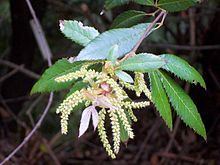Genus Vesselowskya Rank Species | ||
 | ||
Similar Lophozonia moorei, Cunoniaceae, Weinmannia | ||
Vesselowskya rubifolia is a rainforest plant of restricted distribution from eastern New South Wales, Australia. The common name is Mountain Marara or Dorrigo Southern Marara. The species name rubifolia is from the Latin, meaning "bramble". The leaves resemble the blackberry. The genus is named after the Russian botanist E. Vesselowsky.
Contents
Habitat
Growing over creeks in cool rainforest areas. Often associated with the Antarctic Beech. From Cunnawarra National Park near Armidale, New South Wales to the upper Clarence River further to the north.
Description
The Mountain Marara is a bush or small tree to 8 metres tall, and 25 cm in diameter. The bark is thin and fairly smooth, dark brown in colour. With reddish brown bumps in vertical lines. Small branches are thin, green towards the ends with soft hairs. Leaf stipules are between 10 and 15 mm long, ovate and hairy. There are oil glands present at the base of the leaf stipules.
Leaves
The leaves are arranged oppositely on the stem, in groups of threes or fives. The terminal, or largest of the leaves grows to 4 to 12 cm long, 2 to 4 cm wide. The lateral leaves are 3 to 7 cm long, 1.5 to 2.5 cm wide. The smallest basal leaves are 0.5 to 2.0 cm long, 0.5 to 1.7 cm wide. The leaflets at the base are smaller than those at the top of the leaf formation. The leaflets are serrated and have a pronounced tip.
Flowers and fruit
Flowers form from October to December on racemes. The top of the anther is not rounded as with Vesselowskya venusta. Prickles form on the small white anthers. Sepals are hairless on the outside surface.
Fruit matures from March to August, being a pale brown capsule. As the seeds are small, they require a light covering, and seeds should not be buried too deeply in the seed raising mixture.
